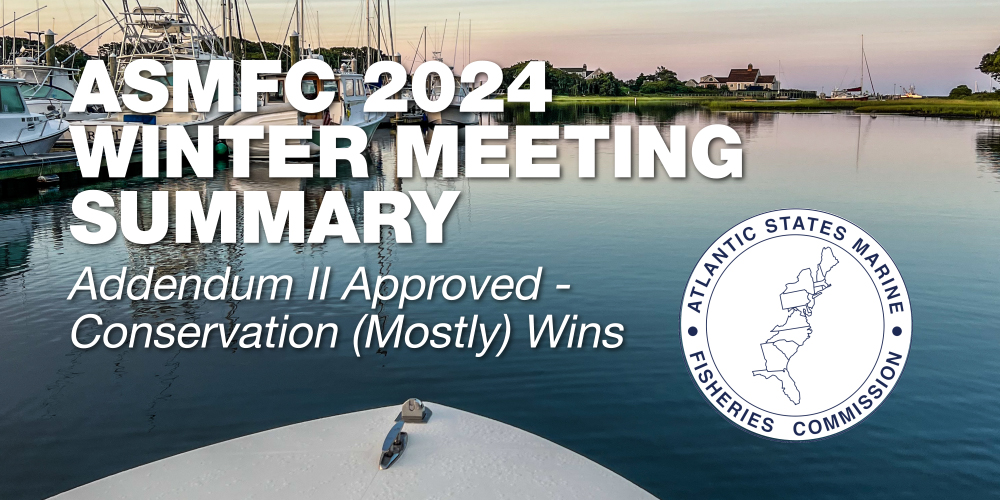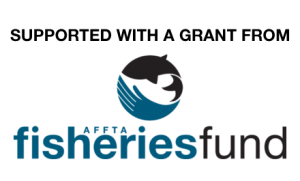ASMFC 2024 Winter Meeting Summary – Conservation (Mostly) Wins

A quick note before we get started with a summary. As we have done in the past, we provided live updates from the meeting through our Instagram account (@stripersforever) stories. If you are unable to attend a meeting it is a great way to stay up to date both during and after the meeting. Instagram is a great tool for connecting us with our supporters, we encourage everyone to give us a follow and to tune into our stories during future ASMFC meetings.
Last Wednesday, January 24, 2024, the Atlantic Striped Bass Management Board met during the ASMFC 2024 Winter Meeting. The final version of Addendum II to Amendment 7 was approved by the board. Conservation (mostly) won, more on the mostly part later. There was a lot on the table with implications to rebuilding of the stock and beyond. For the beyond, there were some options within Addendum II which had the potential to drastically change policy and the future management of Striped Bass. ‘Mode splits’, the elephant in the room, a proposed separation of private and for-hire anglers. Essentially this would have set different regulations for each party, where for-hire patrons would be allowed a wider slot and/or the right to keep more fish. The good news is that none of the options containing mode splits passed, the greater majority of the board realized that it was not the right thing to do and certainly not the right time to make such a drastic policy change. This was a big win for conservation. As Dennis Abbott of New Hampshire stated, “I’m opposed to this motion, I’m opposed to it for a number of reasons. And one of them is that I see a basic unfairness. There are millions of people who fish for Striped Bass and there are a small minority in the for-hire sector. I don’t see how we should advantage one group over the other.” Mr. Abbott went on to give what he termed a ‘sermon’, an inspiring reflection on 28 years of sitting on the Striped Bass board. His words were powerful as he urged the board to “do the right thing for the resource”. It set the stage for the remainder of the meeting, we commend and thank him for such an impactful ‘sermon’.
As you can see for yourself in the Supplemental Materials supplied before the meeting, public comment overwhelmingly supported the most conservation minded options available. It was no surprise that the usual suspects (mainly MD & NJ) would diverge and push for the complete opposite, the shortsightedness of some is astounding. Thankfully their selfish attempts to lead the board down a dark path fell on deaf ears as motion after motion failed and conservation (mostly) won. As you can see below, almost every option we supported passed and for 2024 Addendum II will essentially extend the emergency action ocean recreational fishery regulation of 1-fish at 28-31″ for all modes. So what does conservation (mostly) won refer to? After pleading with the board and multiple attempts at other options to “save the commercial fishery”, the board elected to pass a 7% quota reduction from the ocean and Chesapeake Bay commercial fisheries. In the face of 5 years of poor recruitment in the Chesapeake and now a failed 2023 spawn in the Hudson River, we really hoped the board would elect to maximize the commercial quota reduction at 14.5%. This was not a win for conservation but it was also not a total loss, as the saying goes, the devil is in the detail. Having failed to secure a less conservation minded Chesapeake Bay recreational option, the devilish powers at be shifted focus to delaying the compliance schedule for a variety of reasons that other board members saw through like the clear waters of a flat at high sun. An attempt to delay commercial compliance until 2025 failed and in its place a motion passed in which states must implement regulations (both recreational and commercial) by May 1, 2024. Another big win for conservation.
Below is a breakdown of each final motion as passed by the board. The bullet points that follow summarize our reactions along with some points derived from questions we have been asked following the meeting. Also below, links to; ASMFC press release, presentation slides, meeting recording and the 2024 Winter Meeting Summary.
3.1.1 Ocean Recreational Options – Move to approve in Section 3.1.1. Ocean Recreational Fishery Option B: 1-fish at 28-31″ with 2022 seasons for all modes. Motion passes 14-2-0-0.
- After much discussion and a failed attempt at Option C (mode splits), the board voted to pass Option B, our preferred option. This option secures the greatest overall reduction, protection for the 2015-year class as they mature and does so in a fair and equitable way across all sectors. A great win for conservation in 2024.
3.1.2 Chesapeake Bay Recreational Options – Move to approve in Section 3.1.2. Chesapeake Bay Recreational Fishery Option B2: 19-24″ slot, 1-fish for all modes, 2022 seasons. Motion passes 14-2-0-0.
- Maryland tried relentlessly to convince the board to go against the will of the people. After three failed attempts, we can thankfully say, they were smarter than that. Again we avoided an option with mode splits. And while the slot gained an inch over the prefered Option B1 (19-23″), we have to consider this a win as things could have gone much worse. In typical fashion, only MD and NJ were in opposition to the final motion. Option B2 creates more uniform regulations across the bay and similarly to Option B1 is estimated to meet the 14.5% overall reduction. Given the circumstances we will put this in the win column.
3.1.3 For-Hire Management Clarification
- Because no options containing mode splits were selected by the board this section did not require any action.
3.1.4 Recreational Filleting Allowance Requirements – Move to approve in Section 3.1.4 Recreational Filleting Allowance Requirements Option B: For states that authorize at-sea/shore-side filleting of striped bass, establish minimum requirements, including requirements for racks to be retained and possession to be limited to no more than two fillets per legal fish. Motion passes 15-0-0-2.
- This was a fairly easy topic of discussion and with only a slight adjustment the board passed Option B. This is very simple, in the event that a conservation officer boards a vessel or checks on a shore angler, it would be possible for that officer to know whether or not the fish was legally harvested. We are adding to the toolkit law enforcement has to ensure compliance by the anglers, again we were happy to see this pass.
3.2.1 Commercial Quota Options – Move to approve in Section 3.2.1 Commercial Quota Reduction Option B: 7% reduction from Ocean and Chesapeake Bay 2022 quotas with 2022 size limits.
- This was the one section where we had hoped to see a larger reduction of 14.5%. But there are a couple of important points to consider here. Some of the following points answer questions we heard following the meeting on January 24th.
- There were only two options for the board to choose from; Option A- Status Quo and Option B- A reduction from zero to 14.5%. After the motion for status quo failed the board had to decide on the actual percent reduction.
- We hoped they would max it out but that was not in the cards. Keep in mind, this is a reduction in quota, not harvest. The reality is that some states would not have seen any reduction at all, whether it was 7% or 14.5%. This is, in our opinion, a failure of the Addendum but a reality of the language within it.
- NJ will need to factor this reduction in when converting their commercial quota to the recreational bonus tag program.
- Thankfully, due to the agreed upon compliance schedule (below) we will actually see this reduction take effect in 2024. Prior to this meeting that was very much up in the air.
- It is likely that Addendum II measures will only be in effect for the 2024 season. As noted below in section 3.3, the board will be able to quickly react to the next stock assessment in the fall of 2024. Given the failed recruitment (spawning) in both the Chesapeake Bay and Hudson River, we are preparing for some bad news in that next assessment. If that is how things turn out, the board will likely take much stronger action to ensure we stay on track to recover the stock by 2029. That means we will be back at the drawing board to implement new measures for the 2025 fishing season.
3.3 Stock Assessment Response Options – Move to approve in Section 3.3 Response to Stock Assessments Option B: Board could respond via Board action to change management measures by voting to pass a motion at a Board meeting. Motion made by Dr. Davis, second by Mr. Borden. Passes 11-5-0-0.
- As we mentioned above, there is a really good chance that Addendum II will only be in effect for a one year period. The next stock assessment results are expected in the fall of 2024. Given the 5 years of very poor recruitment in the Chesapeake Bay and a failed spawn in the Hudson River in 2023, there is a good chance that stronger management changes will be needed to ensure a greater than 50% chance of rebuilding by 2029. If the board is required to do so via another Addendum, that process could take close to a year to finalize. The Striped Bass stock does not have that kind of time right now. Option B would allow the board to react by voting by a simple majority. While we prefer to have a public comment period, it just becomes a cumbersome and time consuming process which puts us farther behind in terms of rebuilding. This is unfortunate, the writing has been on the wall for years and as you are probably already aware, Stripers Forever has been calling for the most conservative measures since the beginning of the Amendment 7 process. If the results of the next stock assessment are as bad as we anticipate, the conversation about a equitable harvest moratorium will most certainly be back on the table.
Compliance Schedule – Move to approve the following compliance schedule: States must submit implementation plans by March 1, 2024. The Board will review and consider approving implementation plans in March 2024. States must implement regulations by May 1, 2024. Motion by Dr. Armstrong, second by Mr Borden. Motion passes 10-4-0-2.
- There was a lot of uncertainty around the implementation schedule. We heard in previous meetings that some states would not be able to implement commercial regulations for the 2024 season. The reasoning was suspicious and centered largely around the inability to generate the physical tags that were needed. Having already passed only a 7% commercial reduction, delaying until 2025 would have effectively cut that in half yet again. Thankfully the majority of the board saw through this and after a failed motion to delay until 2025, a motion passed in which all states would be required to implement regulations no later than May 1, 2024. This was a really big win!
From the ASMFC:
ASMFC Atlantic Striped Bass Board Approves Addendum II – Establishes Measures to Continue Progress Towards Stock Rebuilding
Arlington, VA – The Commission’s Atlantic Striped Bass Management Board approved Addendum II to Amendment 7 to the Interstate Fishery Management Plan (FMP) for Atlantic Striped Bass. The Addendum modifies recreational and commercial measures to reduce fishing mortality in 2024, establishes an expedited response process to upcoming stock assessments, and addresses requirements for recreational filleting. Addendum II builds upon the 2023 emergency action by changing the measures in the FMP to reduce fishing mortality and support stock rebuilding. Addendum II measures will replace the emergency action measures upon its implementation by the states by May 1, 2024.
“First and foremost, thank you to the 2,000 members of the public who submitted public comments. The Board had difficult issues to discuss, and public comments were a crucial part of the deliberations,” said Board Chair Megan Ware from Maine. “The Board remains focused on rebuilding the stock by 2029. The upcoming 2024 stock assessment will be an important checkpoint on progress toward rebuilding.”
For the ocean recreational fishery, the Addendum implements a 28” to 31” slot limit, 1-fish bag limit, and maintains 2022 season dates for all fishery participants; this maintains the same ocean recreational measures adopted under the recent emergency action. For the Chesapeake Bay recreational fishery, the Addendum implements a 19” to 24” slot limit, 1-fish bag limit, and maintains 2022 season dates for all fishery participants. For the commercial fishery, the Addendum reduces commercial quotas by 7% in both the ocean and Chesapeake Bay.
To address concerns about recreational filleting allowances and compliance with recreational size limits, the Addendum establishes two requirements for states that authorize at-sea/shore-side filleting of striped bass: racks must be retained and possession limited to no more than two fillets per legal fish.
To enable an expedited management response to upcoming stock assessments prior to the 2029 rebuilding deadline, the Addendum establishes a mechanism allowing the Board to respond to a stock assessment via Board action if the stock is not projected to rebuild by 2029.
States must submit implementation plans by March 1, 2024 for Board review and approval, which will take place at a special Board meeting to be scheduled for later in March. All Addendum II measures must be implemented by May 1, 2024.
The press release can also be found at: https://asmfc.org/files/2024WinterMeeting/2024WinterMeetingSummary_revised.pdf
For more information, please contact Emilie Franke, Fishery Management Plan Coordinator, at efranke@asmfc.org or 703.842.0740.
ADDITIONAL LINKS
- Atlantic Striped Bass Board 2024 Winter Meeting: Presentations (PDF)
- Atlantic Striped Bass Board 2024 Winter Meeting: Meeting Recording Audio/Video (YouTube)
- ASMFC 2024 Winter Meeting Summary: 2024 Winter Meeting Summary (PDF)






